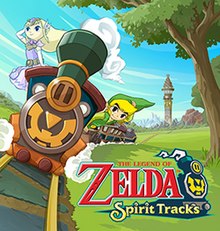| The Legend of Zelda: Spirit Tracks | |
|---|---|
 Promotional artwork | |
| Developer(s) | Nintendo EAD |
| Publisher(s) | Nintendo |
| Director(s) | Daiki Iwamoto |
| Producer(s) | Eiji Aonuma |
| Designer(s) |
|
| Programmer(s) |
|
| Artist(s) |
|
| Composer(s) |
|
| Series | The Legend of Zelda |
| Platform(s) | Nintendo DS |
| Release | |
| Genre(s) | Action-adventure |
| Mode(s) | |
The Legend of Zelda: Spirit Tracks[a] is a 2009 action-adventure game developed and published by Nintendo for the Nintendo DS handheld game console. Set a century after The Wind Waker and its sequel Phantom Hourglass, the storyline follows the current incarnations of Link and Princess Zelda as they explore the land of New Hyrule to prevent the awakening of the Demon King Malladus. Players navigate New Hyrule, completing quests that advance the story and solving environmental and dungeon-based puzzles, many requiring use of the DS's touchscreen and other hardware features. Navigation between towns and dungeons is done using a train, which features its own set of mechanics and puzzles.
Production began in 2007 following the release of Phantom Hourglass, with half the team including director Daiki Iwamoto and producer Eiji Aonuma returning. Aonuma got the concept from a children's book and incorporated some of its elements into the game. Originally planned as a quickly-produced sequel similar to Majora's Mask, production lasted two years due to the new features. The character of Zelda was given more agency and a key role in both the narrative and several puzzles, breaking away from her earlier passive characterisations. The game was lauded by critics from both dedicated video game outlets and general journalistic sites. Praise was directed towards its narrative and gameplay concepts.
Cite error: There are <ref group=lower-alpha> tags or {{efn}} templates on this page, but the references will not show without a {{reflist|group=lower-alpha}} template or {{notelist}} template (see the help page).